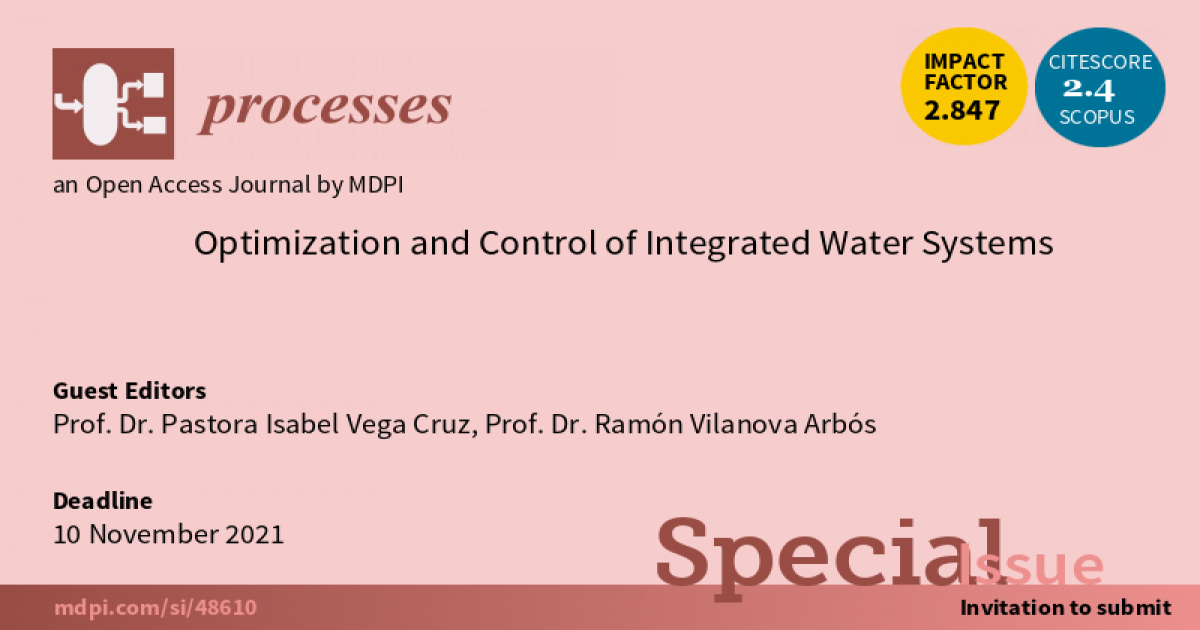Optimization and Control of Integrated Water Systems
A special issue of Processes (ISSN 2227-9717). This special issue belongs to the section "Process Control and Monitoring".
Deadline for manuscript submissions: closed (10 November 2021) | Viewed by 11736

Special Issue Editors
Interests: optimal operation and control of wastewater treatment systems; distributed control of sewer systems; optimization of integrated water systems (IWS); multi-agent-based MPC distributed control; model predictive control and economic model predictive control of IWS; integrated design; advanced control
Special Issues, Collections and Topics in MDPI journals
Interests: wastewater control systems; PID control systems; event-based control; systems with uncertainty; analysis of control systems with several degrees of freedom; application to environmental systems
Special Issues, Collections and Topics in MDPI journals
Special Issue Information
Dear Colleagues,
In the current market-driven industrial field, complex plants that deal with material recycling and heat integration are increasingly appearing, motivated by the considerable improvement of economic efficiency. Beyond economic motivations, the transition to a more sustainable production model implies increasing system complexity, introducing more recycling to save energy and raw materials and minimize emissions to water, air, and soil. On the other hand, in the pursuit of more sustainable scenarios, the circular economy concept develops strategies and ideas for the treatment processing and reuse of waste, providing a second life, reducing the final waste to a minimum, as well as generating economic opportunities.
Particularly, these issues apply to water systems as they are clear candidates for improving water quality, safety, and reliability minimizing energy consumption and gas emissions. Although traditionally, the wastewater treatment plant (WWTP), the sewer system, and the receiving water bodies have been considered as separate systems, they are interacting parts of a more complex system, the integrated water system (IWS). Therefore, this Special Issue will explore the more appealing control issues that appear when performing coordinated control of the IWS. Moreover, advanced control and supervision methodologies can be used within a circular economy framework to offer solutions to account for the interactions between the subsystems comprising the IWS. These techniques can be applied by using actual communication and computation facilities at reasonable costs. The circular economy concept allows for the assessment of environmental impact from a life cycle perspective and for the consideration of many relevant aspects into the IWS analysis.
This Special Issue on the "Optimization and Control of Integrated Water Systems" will bring together methodologies for the optimization, supervision, and control of integrated water systems using advanced operational strategies. Plant-wide supervision and control schemes, based on game and artificial intelligence theories, are appealing approaches for an efficient solution to this complex problem, as long as they are properly integrated with classical ones. Furthermore, their implementation within a circular economy framework will ensure better behavior of the integrated water system as a whole.
Topics include but are not limited to the following:
- Theoretical and practical advances in modeling, simulation, and control of integrated water systems
- Hybrid systems and mixed-logical dynamical modeling for control of IWS
- Decentralized and agent-based modeling of IWS
- Optimization of IWS and their components
- Environmental and economic distributed MPC control of IWS
- Multi-agent game-based distributed MPC of IWS
- Decentralized, cooperative, and coordinated distributed MPC control of IWS
- Networked systems and sectorization methodologies
- Weather forecasting disturbance inclusion in control algorithms applied to integrated water systems
- Learning Strategies for multi-agent systems
- Data-driven fault detection, diagnosis, and prognosis solutions for integrated water systems
- Life cycle assessment of integrated water systems
- Water–energy nexus
- Smart technology and IoT impact on integrated water system management
This special issue is focused more on processes. Papers focus on automation and control may choose our joint Special Issue in Automation (ISSN 2673-4052).
Prof. Pastora Isabel Vega Cruz
Prof. Ramón Vilanova Arbós
Guest Editors
Manuscript Submission Information
Manuscripts should be submitted online at www.mdpi.com by registering and logging in to this website. Once you are registered, click here to go to the submission form. Manuscripts can be submitted until the deadline. All submissions that pass pre-check are peer-reviewed. Accepted papers will be published continuously in the journal (as soon as accepted) and will be listed together on the special issue website. Research articles, review articles as well as short communications are invited. For planned papers, a title and short abstract (about 100 words) can be sent to the Editorial Office for announcement on this website.
Submitted manuscripts should not have been published previously, nor be under consideration for publication elsewhere (except conference proceedings papers). All manuscripts are thoroughly refereed through a single-blind peer-review process. A guide for authors and other relevant information for submission of manuscripts is available on the Instructions for Authors page. Processes is an international peer-reviewed open access monthly journal published by MDPI.
Please visit the Instructions for Authors page before submitting a manuscript. The Article Processing Charge (APC) for publication in this open access journal is 2400 CHF (Swiss Francs). Submitted papers should be well formatted and use good English. Authors may use MDPI's English editing service prior to publication or during author revisions.
Keywords
- Distributed predictive control (DMPC)
- fuzzy logic, multi-agent systems (MAS)
- reinforced learning systems
- game theory
- data-driven fault detection, diagnosis and prognosis methods
- deep learning
- integrated water systems (IWS)
Benefits of Publishing in a Special Issue
- Ease of navigation: Grouping papers by topic helps scholars navigate broad scope journals more efficiently.
- Greater discoverability: Special Issues support the reach and impact of scientific research. Articles in Special Issues are more discoverable and cited more frequently.
- Expansion of research network: Special Issues facilitate connections among authors, fostering scientific collaborations.
- External promotion: Articles in Special Issues are often promoted through the journal's social media, increasing their visibility.
- e-Book format: Special Issues with more than 10 articles can be published as dedicated e-books, ensuring wide and rapid dissemination.
Further information on MDPI's Special Issue polices can be found here.






